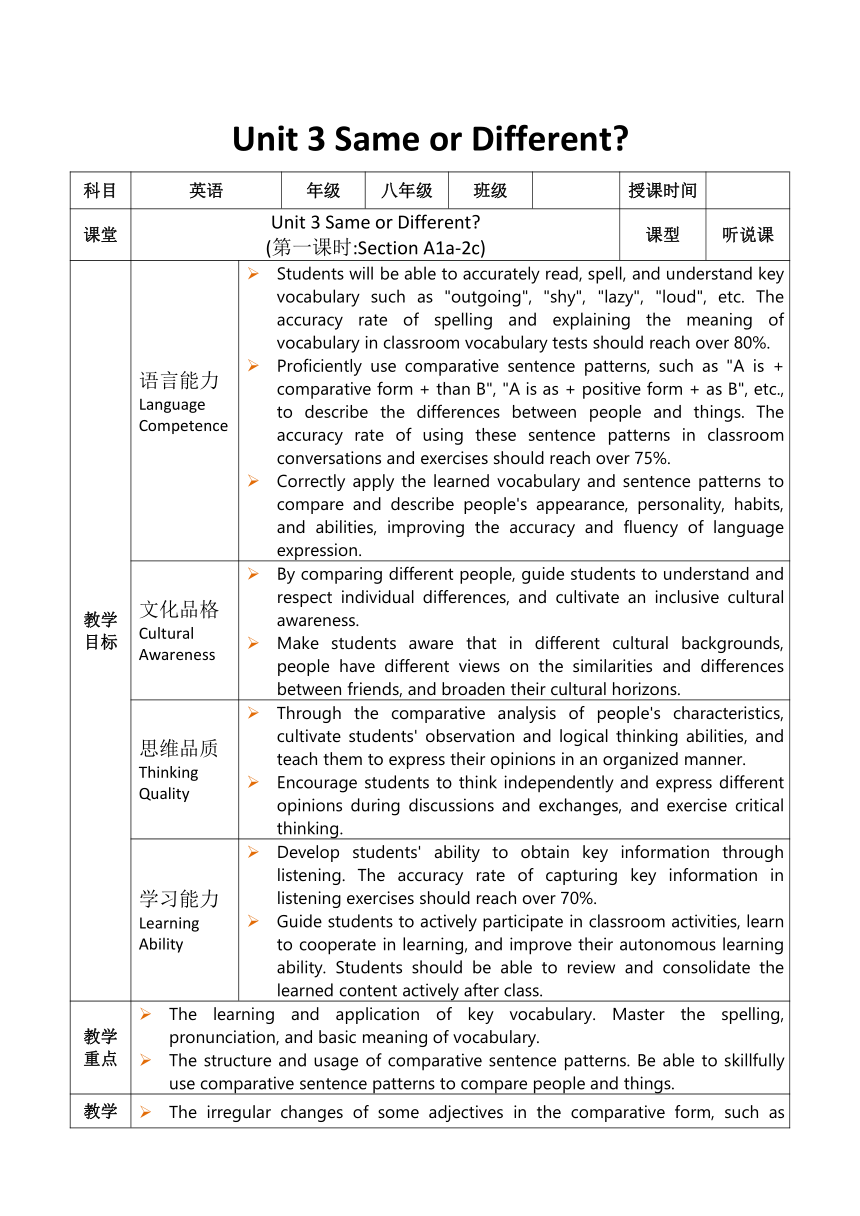
Unit 3 Same or Different 科目 英语 年级 八年级 班级 授课时间 课堂 Unit 3 Same or Different (第一课时:Section A1a-2c) 课型 听说课 教学目标 语言能力 Language Competence Students will be able to accurately read, spell, and understand key vocabulary such as "outgoing", "shy", "lazy", "loud", etc. The accuracy rate of spelling and explaining the meaning of vocabulary in classroom vocabulary tests should reach over 80%. Proficiently use comparative sentence patterns, such as "A is + comparative form + than B", "A is as + positive form + as B", etc., to describe the differences between people and things. The accuracy rate of using these sentence patterns in classroom conversations and exercises should reach over 75%. Correctly apply the learned vocabulary and sentence patterns to compare and describe people's appearance, personality, habits, and abilities, improving the accuracy and fluency of language expression. 文化品格 Cultural Awareness By comparing different people, guide students to understand and respect individual differences, and cultivate an inclusive cultural awareness. Make students aware that in different cultural backgrounds, people have different views on the similarities and differences between friends, and broaden their cultural horizons. 思维品质 Thinking Quality Through the comparative analysis of people's characteristics, cultivate students' observation and logical thinking abilities, and teach them to express their opinions in an organized manner. Encourage students to think independently and express different opinions during discussions and exchanges, and exercise critical thinking. 学习能力 Learning Ability Develop students' ability to obtain key information through listening. The accuracy rate of capturing key information in listening exercises should reach over 70%. Guide students to actively participate in classroom activities, learn to cooperate in learning, and improve their autonomous learning ability. Students should be able to review and consolidate the learned content actively after class. 教学重点 The learning and application of key vocabulary. Master the spelling, pronunciation, and basic meaning of vocabulary. The structure and usage of comparative sentence patterns. Be able to skillfully use comparative sentence patterns to compare people and things. 教学难度 The irregular changes of some adjectives in the comparative form, such as "good - better", "bad - worse", etc. Students need to accurately remember and apply them. In real - life situations, flexibly use comparative sentence patterns for accurate and natural expressions, and avoid grammar mistakes and inappropriate expressions. 教具准备 Multimedia equipment, PPT courseware, word cards 教学内容及过程 教学方法及手段 Step 1 Lead - in (5 minutes) Greet students warmly and have a simple daily conversation, such as "How are you today " "What did you do yesterday " to create a relaxed classroom atmosphere. Show two pictures of people with obvious differences in height, ... ...
~~ 您好,已阅读到文档的结尾了 ~~

